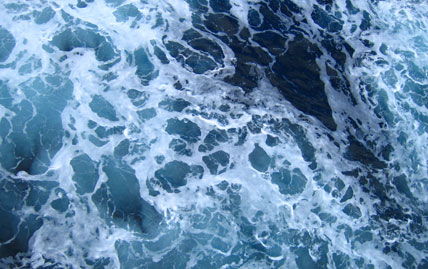Mal de Mer—Thank you for dancing in this space.

Standing at the seaside in CRAB/Portside Park, looking across Burrard inlet toward the north shore mountains, who doesn’t want to bow and undulate in harmony? Mal de Mer, by Anatomica/ Proximity Arts, begins with the exquisitely satisfying tableau of two women (Susan Elliott and Tanya Marquart) swathed in sails, swaying in the thigh-high waves. What a pleasure to spend an hour in this gorgeous outdoors, as it is animated and given further shape by the engaging narratives (our sea-monkey origins? swimming with whales? drowning?), sound design (Emma Hendrix), sets (Jesse Garlick and Barnaby Killam) and movement structures of Mal de Mer.
To get to the performance site, the audience is guided from the Firehall Arts Centre through the downtown eastside by a jolly sailor. He invites us to move through the sea, to see things fresh, to stay together, essentially mapping the ideas of seasickness and the watery element onto the urban landscape. The result for me was that I began looking for the performance right away. Yet I think that neither the intent nor the effect was to make the downtown east side a show. Instead, the experience is of seeing everyday things and people with new openness. And when we arrive at the beach, it is clear exactly where the performance is.
The audience, distributed over driftwood on the beach, is equipped with head phones that broadcast the soundscore for the piece, and is gazing at the women in the water, who look at times in harmony in the environment and at times sea sick. By the time the dancers eventually come ashore, a curious police zodiac has come to check things out from the sea side.
In the next scene, the dancers shed their sails and waders and move uphill, unfurling a sail against the green slope while the voice in our ears tells of seamonkey ancestors and explains that our hair points downwards and our hands still have a bit of webbing because we used to be sea creatures. The set here includes several triangular sails tented on the grass, and I fully expected more dancers to appear from these blinds. This did not occur, but no matter. The third scene takes place on a teeter-totter stage. After the two dancers explore its rhythms and rollings (Elliott’s compact ease balancing and complementing Marquart’s rangy grace), Elliott ties it in place, so that it will no longer rock, and leaves. Marquart, abandoned and confused, tries with increasing desperation to keep playing. She has missed something. The slightly comic pathos of this moment counterbalances the story of drowning and rescue that comes over the sound score. In the last scene, the two dancers, together again, execute a tidy jig on the pier. It was fun to encounter this beautiful and energetic traditional dance at the end of the piece.
I appreciated the subtle modulations of tone in this piece, the understated use of the dramatic site, and the technical clarity at all levels (sound delivery, reworking of motifs and themes, movement choices, narrative elements). More like this!



